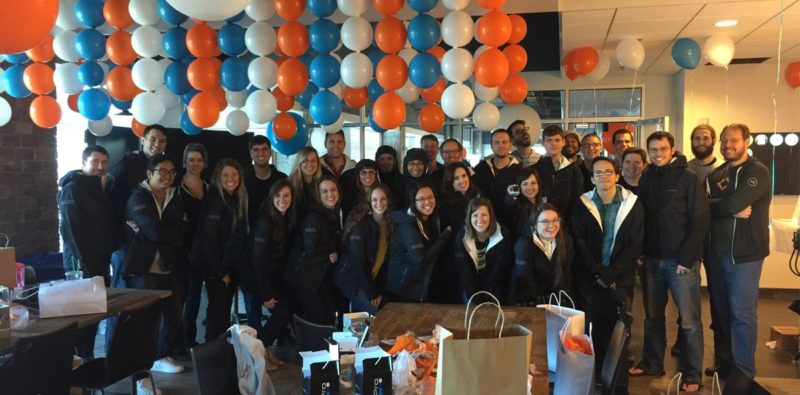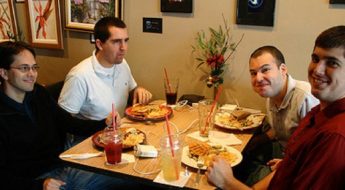
The actual room at Pluralsight in Salt Lake City.
It was a Tuesday in late October 2015 and I was dreading the conversation I was about to have. I was sitting across from Aaron Skonnard (CEO) and Greg Woodward (CFO) of Pluralsight, two people who I had come to admire and respect. Unfortunately, I had to tell them that I wanted to leave the company, Code School, that they had acquired 12 months prior. I felt like I was going to be sick.
Why Step Away?
People seem to assume that when the founder leaves a company it’s either because the acquiring company changed things for the worse, or the founder wanted the company to be acquired so they could immediately jump to the next startup. Neither could be further from the truth. I didn’t leave because Pluralsight came in and screwed stuff up. In fact, when Code School was first acquired I didn’t plan on going anywhere for a long time.
Code School to this day is an amazing place to work, full of craftspeople who are extremely passionate about what they do. People who enjoy helping others learn new technologies, who care a great deal about having a safe and trusting work environment.
Pluralsight also has an exceptional leadership team, board of directors, and investors who are the right people to steer the company to even greater success. They work with Code School as a separate business unit, finding the right balance of autonomy, allowing the Orlando team to feel empowered even though they don’t work at headquarters in Farmington, Utah.
Why then would I ever want to leave?

The Decision for Acquisition
As I mentioned in my third founder’s talk, at the beginning of 2014 Code School was in a unique position, having just passed 5 Million in annualized run rate. Annualized run rate, in case you’re not familiar, is taking the most recent month’s revenue and multiplying it by 12. It was at this point where I realized we had three choices.
1. Continue trying to grow the business ourselves.
Code School growth had always been slow and steady; there wasn’t a hockey stick in sight.
2. Look for strategic investment that would help us scale.
I knew that if we wanted to go from 5 Million to 50 Million we would need to bring in more experienced help. One way to get this help would be to find investors who could help advise us. Also, I’d never figured out the whole “board of directors” thing (we didn’t have one), and this would offer the best opportunity to change that.
3. Look for a company we would fit well with, who was interested in acquiring Code School.
The best time to look for a potential merger or acquisition is right before you accept investment. As soon as you accept investment your investors are going to prefer you get acquired for 10x your current valuation.
The best time to look for a potential merger or acquisition is right before you accept investment.Click To TweetSo I realized that now would be the right time to entertain an acquisition. If it didn’t work out that would be ok too, we’d consider the investment approach and shoot for the moon. It was around this time that I received some great advice from Cliff Ingari, a local CEO. Cliff made me realize that I should be very up front with a potential acquiring company with what my goals are. I came up with these:
1. They must be willing to preserve our culture, jobs, and location.
Notice that this is #1. When I said that we put people first, I meant it. This was non-negotiable.
2. They must value our product and be a good strategic fit.
We all wanted to make Code School available to more students. One way to do this would be to join a company who had means to get our product out to a bigger audience. This could mean that they have a larger sales and marketing team, or they have a bigger mailing list.
They also might have a product that fit well with ours, as Pluralsight did. One of Code School’s biggest weaknesses was that we didn’t have a lot of depth to our content. This was on purpose; we were focused on being the best place to start learning new technology. Often we only had the first 2 courses on a given topic. One of Pluralsight’s strengths was already having a huge library of content, often having 10 or more courses on a popular topic. Their strength matched our weakness.
3. The deal had to be for both cash and equity (aka stock).
I wanted everyone to participate in the future success of our hard work, so I wanted a deal involving both cash and ownership in the company. IMHO everyone deserves to have some ownership in a company they work for.
IMHO everyone deserves to have some ownership in a company they work for.Click To TweetI started looking for potential acquirers in January, and we closed November 1st. Yeah, not a short process, but I learned a ton along the way about how to do acquisitions.

Our team celebrating the announcement of the acquisition.
After the Acquisition
We announced the acquisition in late January, and not much changed at Code School. Pluralsight made it clear to the entire company that Code School was going to remain autonomous within the organization and under my leadership.
So what did change?
- We became more organized planners. I’ve never spent enough time planning and setting goals. Pluralsight showed us how they managed their quarterly and annual planning and we followed their lead. I really enjoyed this process, and it’s certainly something I’ll be doing more of in the future.
- I got my advisory board. Every quarter we’d visit Pluralsight, get to spend quality time with their executive team, and get fantastic feedback on our quarterly/yearly goals. Every month we’d have a video meeting with leadership where we’d discuss progress.
- Focus Shifted to Product Design. Pluralsight at the time was building their product team. Code School began to emulate this process by hiring new some new staff who had more experience with product design.
- Access to a Sales Team. Eventually, we started working with the big Pluralsight sales team so they could sell Code School alongside their product, letting me off the hook for building the Code School sales department. Yay!
So Again, Why Leave?
By August 2015 (about 9 months after the acquisition) I’d noticed that I wasn’t nearly as motivated as I used to be. I found myself daydreaming about creating my own content again and starting a new business some day. My day was filled with CEO like activities that didn’t leave me feeling satisfied at the end of the day.
I wanted to get back to making an impact with content I was producing. I wanted to move faster and break things. I wanted to start over. I wanted fewer meetings.
I wanted to get back to doing the work that brought me the most happiness, and I could no longer see a way to do this from within the organization. As a bit of a control freak I don’t like to feel limits on my creativity, and I don’t like feeling like I have a boss. I’m also extremely opinionated when it comes to product and content. I wouldn’t be able to sit back as a content producer at Code School and not be a backseat CEO. Inevitably it would undermine the leadership.
So I spoke with a few CEO friends, including Cliff, and got some advice on how to break it to Pluralsight that I eventually wanted to step away. I was extremely nervous about how they would take the news, probably the most nervous I’d been in the last 5 years.

Remember the start of this article? There I sat at Pluralsight in Salt Lake City amongst the couches and wood wall behind me. I knew how much it hurt me when talented people told me they were leaving my companies. It made me feel like a failure, and here I was about to do the same thing to the individuals who took a huge risk acquiring my company. They trusted me and I was about to break that trust.
However, when it came time to tell them I was giving six months notice, and I was going to work hard those six months on succession planning, they reacted with the same grace and understanding I had always received from them. Class acts, all of them, and I’d gotten all worked up over nothing.
Succession Planning
We could have written up a CEO job description and posted a help wanted ad. I could have promoted someone from within and just had them shadow me. I think both of these situations would have failed miserably, as I’d seen in other companies.
Thankfully, at Code School we worked with an Organizational Psychology team, specifically Stephanie Lopez from Key Talent Solutions. Stephanie helped me map out a succession plan for the next six months so we could identify the leadership Code School needed, and find the right people for the role or roles.
Data Collection
I started the process and met with each of my Directors at Code School, told them the news, and asked them what their biggest concerns were about my leaving. I took notes which informed the next step. I also decided to keep my plans from the larger team, so that by the time they learned I was leaving the succession plan would be almost complete.
Creating an Executive Director Role
There were eight directors at Code School, and we needed to create a position that would support those directors. Notice I didn’t say the position is “in charge of” the Directors, or “sits above” the directors. An Executive Director’s job to support and empower the directors who report to them. Terminology is important in a culture of openness.
Over the next few months we gained alignment on the Executive Director role from all the directors and then each team member. It wasn’t a short process.
December
We interviewed Thomas Meeks and Ashley Smith for the role and decided to allow them to both to have it (they make a great team). Having them go through the formal interview process was invaluable. It put them in a position to open and honest about what their strengths (and more importantly) weaknesses are. It also showed them how to interview for the role if they ever leave.
Late December we announced them moving into the roles.
January
I started handing over my responsibilities to Thomas and Ashley, and taking a back seat. They ran our Monday standup, took over Director 1 on 1s (which I had previously done), led weekly director meeting, and started doing more product strategy.
February / March / April
I took more and more of a backseat and did my best to let Ashley and Thomas lead. I spent more and more of my time working on the Angular 2 course.
April 11
On this day I let the greater company know that I was leaving, and my last day would be May 18th. By this time many people saw Ashley and Thomas stepping up to be greater leaders of the organization. I was confident that I could step away, but I knew others would be affected with this news. If you’re interested, I wrote this letter and read it to the team.
In the weeks that followed I worked on the Angular 2 course, and met with just about everyone who wanted to chat. I also received some amazing thank you notes from everyone that I will cherish forever. Then I put the Code School chapter behind me and went on my summer adventure.

Final Thoughts
- If you ever find yourself in a situation where you want to step away from your company or want to take a different role, it is possible and you can do it. For the best results, find an organizational psychologist like you’ll find at Key Talent Solutions.
- Keeping information secret from your greater team (in this case that I was planning on leaving) is sometimes the right thing to do so you can be deliberate. This initially felt contrary to my core value of transparency/integrity, but it was the right thing to do.
- You can be just as thoughtful leaving a company as you were building it.
If you want to learn more about what I learned the hard way building Envy Labs and Code School, be sure to check out my founder’s talks, especially 12 ways to put people first and build effective teams. I also recently put together a video on
what I did right and wrong when it comes to product & content marketing.







Greg, this was a humbling and inspiring article. Thank you for sharing your experience and learnings with the rest of us trying to find our way through the entrepreneurial journey. Growing my own company has been the most challenging professional experience of my life and your story offers the type of inspiration that I admire. Enjoy creating your next big adventure! There are many of us Orlando folk curious on what you will innovate next.
Thanks for sharing Gregg.
Hi Greg,
Thanks for sharing and openness.
I took courses at Code School and remember your face as one of the instructors.
I hope everything is for the better, and that you made some good money in the process.
Really nice article Gregg! We should catch up some day. -dj
When i am reading this article, it’s too late but very nice article Gregg! Thanks for sharing and opennes.
Wow, what a wonderfully written article! You should have contemplated your options a lot before taking this move. All the best!
Hey Gregg,
Sad to see you leave Code School.
I enjoyed each course I watched with you standing in front of the camera.You are an excellent instructor.
Thank you for sharing your adventure. I’m sure you will do fine wherever you go. It’s not always about money. Sometimes, you gotta follow your gut instinct and what makes YOU happy.
A great read Gregg. A great strategic note. Surely it will help people like me in the future.
Thank you so much for sharing.